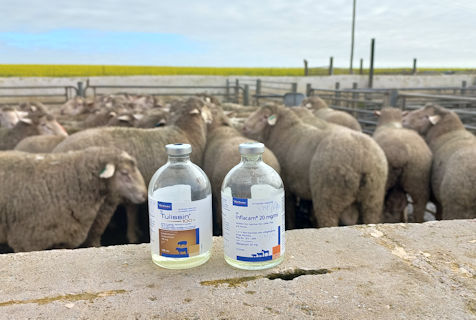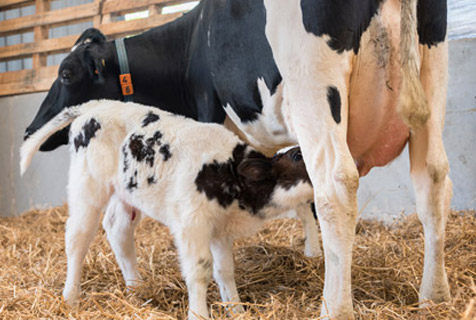Tulathromycin for now.

Bovine respiratory disease (BRD) is one of the most common and economically significant diseases affecting the beef and dairy industry. It is a multifactorial disease that can be caused by various pathogens, including bacteria, viruses, and mycoplasmas. BRD causes significant losses in the industry, especially when the disease is not diagnosed early and treated appropriately. In recent years, Tulathromycin (eg Tulissin 100) has emerged as a highly effective treatment option for BRD in the fall and early winter.
Tulathromycin (eg Tulissin 100) is a macrolide antibiotic that has been shown to have high efficacy against BRD-causing bacteria, such as Mannheimia haemolytica, Pasteurella multocida, Histophilus somni and Mycoplasma. One of the advantages of Tulathromycin (eg Tulissin 100) is that it has a long-time over MIC (minimum inhibitory concentration) in lung tissue, which means it can continue to work against the bacteria even after the concentration of the antibiotic drops in the blood. This makes it an excellent option for BRD treatment, where lung tissue concentration is critical for the successful eradication of bacteria. With the high concentration and long period of action in the lung tissue, a durable cure is achievable. This is reflected in good post-treatment production.
In addition to its efficacy in treating BRD, Tulathromycin has also been reported to have beneficial growth data in cattle. Several studies have shown that cattle treated with Tulathromycin had improved weight gain, feed efficiency, and overall health. The ability to have sustained concentration in the lung tissue helps in this regard. Tulathromycin (eg Tulissin 100)-treated cattle ruminate quicker and rumen health is supported, which again supports quicker recovery and production.
Interestingly, the use of Tulathromycin (eg Tulissin 100) has not been shown to have any effect on the microbiome. The microbiome is the community of microorganisms that reside in the gut of animals and play an essential role in digestion, immunity, and overall health. The use of antibiotics can possibly alter the microbiome, leading to dysbiosis and potential health problems. However, the use of Tulathromycin (eg Tulissin 100) has not been shown to disrupt the microbiome, making it a valuable asset for BRD treatment.
In conclusion, Tulathromycin (eg Tulissin 100) is a highly effective treatment option for BRD in the fall and early winter. Its long-time over MIC in lung tissue, beneficial growth data, and no effect on the microbiome make it an excellent choice for beef producers. As with any antibiotic use, proper diagnosis and treatment is essential to prevent the emergence of antibiotic-resistant bacteria. It is vital to work together with veterinarians, laboratories, and other stakeholders to find a balance between animal health and proper antibiotic stewardship.
References:
TC Tennant et al 2014 Comparison of tulathromycin and tilmicosin on the prevalence and severity of bovine respiratory disease in feedlot cattle in association with feedlot performance, carcass characteristics, and economic factors. J Animal Sci 92 issue 11, pg 5203-5213
Enrico Fiore et al. 2016. Methaphylactic effect of Tulathromycin treatment on rumen fluid parameters in feedlot beef cattle. Can J Vet Res. 2016 Jan; 80(1): 60–65
B Poulsen Nautrup, et al 2013. Estimating the comparative clinical and economic consequences of tulathromycin for treatment of present or anticipated outbreaks of bovine respiratory disease in feedlot cattle in the United States1
Journal of Animal Science, Volume 91, Issue 12, December 2013, Pages 5868–5877,
K. M Abell et al 2017. A mixed treatment comparison meta-analysis of metaphylaxis treatments for bovine respiratory disease in beef cattle. J.Anim. Sci Vol 95: 626-635.
Doster E et al 2018. Investigating Effects of Tulathromycin Metaphylaxis on the Fecal Resistome and Microbiome of Commercial Feedlot Cattle Early in the Feeding Period. Front. Microbiol., 30 July 2018
Comparison of tulathromycin and tilmicosin on the prevalence and severity of bovine respiratory disease in feedlot cattle in association with feedlot performance, carcass characteristics, and economic factors. T. C. Tennant, S. E. Ives, L. B. Harper, D. G. Renter, T. E. Lawrence. Journal of Animal Science, Volume 92, Issue 11, November 2014, Pages 5203–5213, https://doi.org/10.2527/jas.2014-7814
Investigating Effects of Tulathromycin Metaphylaxis on the Fecal Resistome and Microbiome of Commercial Feedlot Cattle Early in the Feeding Period. Front. Microbiol., 30 July 2018 | https://doi.org/10.3389/fmicb.2018.01715
Microbial Ecology Group, Colorado State University, Fort Collins, CO, United States
Department of Microbiology, Immunology and Pathology, Colorado State University, Fort Collins, CO, United States

